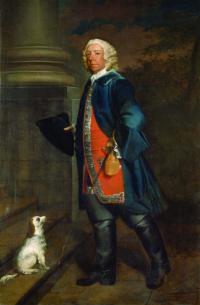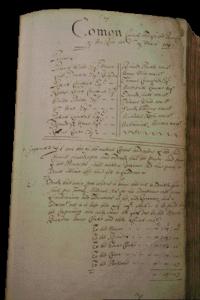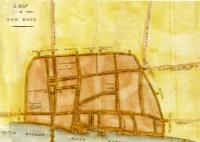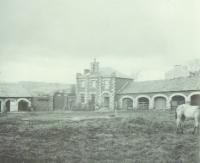Capturing the quotidian: New Ross Corporation Books, 1685–1900
Published in 18th–19th - Century History, Early Modern History (1500–1700), Features, Issue 5 (Sept/Oct 2011), Volume 19
portrait of Charles Tottenham in his boots by James Latham—in 1777, as New Ross council’s treasurer, Tottenham organised the town’s first fire engine, brought from London and costing £57.13s.11d. (National Gallery of Ireland)
The minute books of municipal corporations, while not quite reflecting the views of the humbler citizen, capture the affairs that trouble those with their hands on the levers of power and an eye on the concerns of their ratepayers. The minute books of the town commissioners of New Ross, Co. Wexford, survive from 1685. They capture vividly the unease of the late seventeenth century—the fears of the ruling Protestant minority about the attitudes and affiliations of the Catholic majority. Later political changes by the mid-nineteenth century are reflected in the commissioners’ support for the Tenant Right Association. It is as local history that corporation books are of most value, however.
Quartering of troops
Before the cavalry barracks was built in 1700 on the site of St Michael’s medieval church, a number of entries mention the quartering of dragoons. In 1688 their colonel complained about their lodgings and consequently the citadel, a fortification on the quay, was repaired and a room furnished for the officers on guard. The following year, ordnance stored in the blockhouse, a seventeenth-century fortification on the opposite end of the quay to the citadel, was moved to Duncannon Fort, suggesting an easing of tension locally. The burden of the quartering of troops is illustrated by a 1689 direction that public and private stables were to be put in good order for the horses of the military. Those without stables paid towards their hire. In April 1691, following proposals to withdraw troops, commissioners petitioned the government, noting the ‘daily encroach of rapparees’ and requesting arms and ammunition ‘for 2 companies of foot and one of dragoons’. Every fit man between the ages of sixteen and 60 was required to take part in the watch. Since the ‘Irish’ were not permitted to leave their houses at night, they paid a Protestant to watch in their place.  This provision was repeated in 1779, when ‘for the safety and protection of the town in these times of peril and danger’ (during the American War of Independence) a watch of ten armed men patrolled nightly. When it become the turn of a Roman Catholic, he provided a Protestant in his stead. In 1691 Edmund Sutton, the ferryman, being Irish, employed an Englishman, approved by the sovereign of Ross, who would report on suspect passengers. Irish papists living in the Folly House, earlier occupied by Oliver Cromwell and located close to the Market Gate, one of the main entries to Ross, were evicted and the bailiff ensured that only Protestants occupied the house because of the danger from ‘raparees or torys’. In 1696, when butcher Nicholas Hackett applied to be a freeman, he was admitted free in recognition of his service as a soldier ‘in Derry during ye seige’.
This provision was repeated in 1779, when ‘for the safety and protection of the town in these times of peril and danger’ (during the American War of Independence) a watch of ten armed men patrolled nightly. When it become the turn of a Roman Catholic, he provided a Protestant in his stead. In 1691 Edmund Sutton, the ferryman, being Irish, employed an Englishman, approved by the sovereign of Ross, who would report on suspect passengers. Irish papists living in the Folly House, earlier occupied by Oliver Cromwell and located close to the Market Gate, one of the main entries to Ross, were evicted and the bailiff ensured that only Protestants occupied the house because of the danger from ‘raparees or torys’. In 1696, when butcher Nicholas Hackett applied to be a freeman, he was admitted free in recognition of his service as a soldier ‘in Derry during ye seige’.
Civic officials and fire engines
The offices of the town were the monopoly of particular families, most notably the Tottenhams. In 1688 it was ordered that ‘any of the burgesses, merchants or masters of companies meeting the mayor in the street are to attend him to his house or resting place, except some extraordinary occasion may arise’. The fine for failing to do this was a hefty five shillings. In 1707 it was agreed that for the future the sovereign was to carry ‘the rod of his authority at all times when he walks the streets by which he may be known by strangers and others by way of the distinction’. In 1777 Charles Tottenham, then treasurer, organised the town’s first fire engine, brought from London and costing £57.13s.11d. The fire station was on the Old Customhouse Quay, with a bellman employed on a salary of three pounds. In 1860 subscriptions for a new engine were taken from insurance companies in the town, landlords and Charles Tottenham MP.
![The minutes of New Ross ‘Comon [sic] Council’ held on 6 March 1687, and (below) the names (and coats of arms) of that year’s mayor (or sovereign) and other officials. (New Ross Town Council)](/wp-content/uploads/2013/03/Capturing-the-quotidian-New-Ross-Corporation-Books-1685–1900-3.jpg)
The minutes of New Ross ‘Comon [sic] Council’ held on 6 March 1687, and (below) the names (and coats of arms) of that year’s mayor (or sovereign) and other officials. (New Ross Town Council)
Working conditions and perks
The Corporation Books give a sense of the working life and conditions of town council employees. Many posts came with ‘perks’: clothes, in particular hats and coats, feature regularly. In 1749 the sergeant of the mace, John Rook, was paid twenty shillings in consideration of not having a new coat and hat. The bellman, Luke Johnson, was paid ten shillings for the same reason. In 1857, following their dismissal, three watchmen were ordered to give up their coats and hats. The duties of a watchman, the perils associated with the post and the fact that everyone knew everyone else are outlined in detail in this 1856 account:
‘That the watchmen be directed to be on their beat at eight o’clock every evening and that they take up all the prostitutes that are on the streets from that until five o’clock in the morning or at any other time that the law allows, and likewise that they take up any person misbehaving or using indecent language or behaviour in the street such as George Allen does also that young boy . . . Danny Byrne who is in the habit of annoying females in the streets and all loit[er]ers . . .

Map of New Ross c. 1700. (Tottenham Estate Office)
and that they shall not allow the crowd of idlers that are in the habit of loitering about the Tholsel at night and in case they shall not obey and put this into execution these orders they shall be dismissed and other watchmen appointed.’
In December 1856 three pairs of handcuffs of different sizes were ordered for the watchmen. The next entry shows why this was necessary, as well as illustrating the simmering turf war between members of the watch and the constabulary over the dispensing of law and order:
‘On the evening of December the 25th inst . . . P.W. Thomas Cooney watchman, called upon Sergeant Buchanan to take into custody a disorderly prisoner that was smashing the door, bedstead and wall of the lock up in the Tholsel, and he positively refused to do so. The watchman also called at two o’clock stating again the prisoner was unmanageable and he required assistance but he still refused.’

The town’s corn market—erected in Robert Street in 1818 in an attempt to control and regulate trading. (Jimmy FitzGibbon, Cavanagh Collection)
By 1864 the watchman’s role in arrest and detention was called into question. Legal opinion was sought, in particular regarding the liability of the commissioners.
Regulation of business
There is a consistent concern with the control and facilitation of business. In 1699, for instance, the book records the ‘Articles, ordinances and by laws made and established by ye guilds and fraternity of . . . broguemakers, saddlers, smyths, nailors, skinners, braziors, porters, carriers, leather dressers, tanners, tallow chandlers & soapboilers’—glaziers are also mentioned. The ordinance deals with a variety of matters, including the quality of material, regulation of apprenticeships, relationships to foreign tradesmen, and exercise of civil and militia duties. Non-payment of dues, where distress cannot be argued, resulted in forfeiture followed by prison. ‘Popish’ merchants were admitted to the freedom of the town following their swearing of the oath of allegiance but they did not have a vote. Fairs were vital to the economy of towns such as Ross. In 1783 a clerk of the market was appointed, at a salary of £10 per annum, to see that proper weights and measures were used and ‘to prevent butchers and bakers from committing frauds in their respective occupations’. In 1688 it was ordered that bakehouses were ‘to be made hott and ready by daylight and not by night’. In 1747 there were complaints that butter and salmon were traded at the gates and the roads leading to the town, ‘to the great detriment of the inhabitants and merchants’. In an attempt to control and regulate trading, a corn market was erected in Robert Street in 1818. It was not an outstanding success. In 1828 tradesmen were compelled to weigh and sell their corn at the market house. In 1832 standing markets, deemed an ‘obstruction to passengers in the street’, were to be removed to the corn market.
The river
The importance of the River Barrow to the town is underlined by the number of references to the control of trade on the river, the conduct and appointment of water bailiffs and the duties of the ferryman. The ferry was particularly important from the middle of the seventeenth century to the end of the eighteenth century, when the town was without a bridge. In 1730 the ferry operated ‘from six o’clock in ye forenoon till ten o’clock at night from twenty fifth day of March to Michaelmas and from Michaelmas to twenty fifth day of March from seven of the clock in the morning to nine at night’. There are a series of orders rewarding those who saved people from drowning. In 1810 a premium of 40 shillings was paid to ‘any person who shall save any person who may fall into the river of Ross’. In 1815 a resolution listed a number of persons rewarded for saving people, including a child, who fell from the bridge. The lucky survival of these corporation records gives us a glimpse of the concerns of a small Irish town in great detail over more than two centuries. During this time, politically, the town moved from being a bastion of loyalism, with the plaque on the Tholsel noting that the first stone of the building was laid on the anniversary of the ‘glorious Battle of the Boyne’, to supporting the movement for Irish independence. It is in the minutia, however, that the true value lies—the description of the condition of the streets, the introduction of services such as gaslight and piped water, the purchase of fire engines and the setting up of fire stations, surely an important service in a town with so many houses packed into narrow lanes and streets. Across the years we can see that priorities remained the same: from the seventeenth-century guild ordinances to the meeting called in February 1864 to look into measures to free the bridge from tolls, there is a predominant concern with trade and commerce. HI
Linda Doran is editor of the New Ross section of the Irish Historic Towns Atlas series and lectures in medieval history in University College Dublin.
Further reading:
T. Dunne (ed.), New Ross, Rossponte, Ros Mhic Treoin: an anthology celebrating 800 years (Wexford, 2009).J. FitzGibbon, A time and a place—New Ross 1890 to 1910 (New Ross, 2007).P.D. Vigors, ‘Extracts from the Books of the Old Corporation of Ross, Co. Wexford’, Journal of the Royal Society of Antiquaries of Ireland (5th ser.) 2 (2) (July 1892), 171–6; 2 (3) (October 1892), 287–90; 4 (2) (June 1894), 176–9.
The author would like to thank John Moran of New Ross town council and David Minogue, town clerk, for their assistance.
















